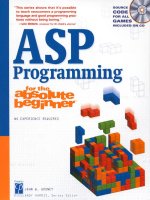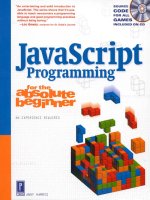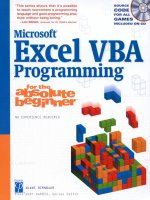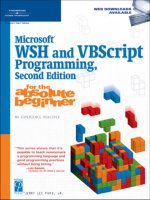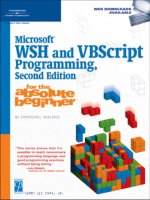C Programming for the Absolute Beginner phần 5 potx
Bạn đang xem bản rút gọn của tài liệu. Xem và tải ngay bản đầy đủ của tài liệu tại đây (1.09 MB, 25 trang )
a function that contains the logic and structures to handle this procedure and then reuse
that function when needed. Putting all the code into one function that can be called repeat-
edly will save you programming time immediately and in the future if changes to the function
need to be made.
Let me discuss another example using the
printf() function (which you are already familiar
with) that demonstrates code reuse. In this example, a programmer has already implemented
the code and structures needed to print plain text to standard output. You simply use the
printf() function by calling its name and passing the desired characters to it. Because the
printf() function exists in a module or library, you can call it repeatedly without knowing
its implementation details, or, in other words, how it was built. Code reuse is truly a pro-
grammer’s best friend!
Information Hiding
Information hiding is a conceptual process by which programmers conceal implementation
details into functions. Functions can be seen as black boxes. A black box is simply a compo-
nent, logical or physical, that performs a task. You don't know how the black box performs
(implements) the task; you just simply know it works when needed. Figure 5.2 depicts the
black box concept.
FIGURE 5.2
Demonstrating
the black box
concept.
Consider the two black box drawings in Figure 5.2. Each black box describes one component;
in this case the components are
printf() and scanf(). The reason that I consider the two
functions
printf() and scanf() black boxes is because you do not need to know what’s inside
of them (how they are made), you only need to know what they take as input and what they
return as output. In other words, understanding how to use a function while not knowing
how it is built is a good example of information hiding.
Many of the functions you have used so far demonstrate the usefulness of information hiding.
Table 5.1 lists more common library functions that implement information hiding in struc-
tured programming.
Chapter 5 • Structured Programming
113
If you’re still put off by the notion of information hiding or black boxes, consider the following
question. Do most people know how a car’s engine works? Probably not, most people are only
concerned that they know how to operate a car. Fortunately, modern cars provide an interface
from which you can easily use the car, while hiding its implementation details. In other
words, one might consider the car's engine the black box. You only know what the black box
takes as input (gas) and what it gives as output (motion).
Going back to the
printf() function, what do you really know about it? You know that the
printf() function prints characters you supply to the computer’s screen. But do you know
how the
printf() function really works? Probably not, and you don’t need to. That’s a key
concept of information hiding.
In structured programming you build components that can be reused (code reusability) and
that include an interface that other programmers will know how to use without needing to
understand how they were built (information hiding).
F
UNCTION
P
ROTOTYPES
Function prototypes tell C how your function will be built and used. It is a common program-
ming practice to construct your function prototype before the actual function is built. That
statement was so important it is worth noting again. I
It is common
p
programming practice
to construct your function prototype before the actual
f
function is built.
Programmers must think about the desired purpose of the function, how it will receive
input, and how and what it will return. To demonstrate, take a look at the following function
prototype.
T
ABLE
5.1 C
OMMON
L
IBRARY
F
UNCTIONS
Library Name Function Name Description
Standard input/output
scanf()
Reads data from the keyboard
Standard input/output
printf()
Prints data to the computer monitor
Character handling
isdigit()
Tests for decimal digit characters
Character handling
islower()
Tests for lowercase letters
Character handling
isupper()
Tests for uppercase letters
Character handling
tolower()
Converts character to lowercase
Character handling
toupper()
Converts character to uppercase
Mathematics
exp()
Computes the exponential
Mathematics
pow()
Computes a number raised to a power
Mathematics
sqrt()
Computes the square root
C Programming for the Absolute Beginner, Second Edition
114
float addTwoNumbers(int, int);
This function prototype tells C the following things about the function:
• The data type returned by the function—in this case a
float data type is returned
• The number of parameters received—in this case two
• The data types of the parameters—in this case both parameters are integer data types
• The order of the parameters
Function implementations and their prototypes can vary. It is not always necessary to send
input as parameters to functions, nor is it always necessary to have functions return values.
In these cases, programmers say the functions are void of parameters and/or are void of a
return value. The next two function prototypes demonstrate the concept of functions with
the
void keyword.
void printBalance(int); //function prototype
The void keyword in the preceding example tells C that the function printBalance will not
return a value. In other words, this function is void of a return value.
int createRandomNumber(void); //function prototype
The void keyword in the parameter list of the createRandomNumber function tells C this function
will not accept any parameters, but it will return an integer value. In other words, this func-
tion is void of parameters.
Function prototypes should be placed outside the
main() function and before the main() func-
tion starts, as demonstrated next.
#include <stdio.h>
int addTwoNumbers(int, int); //function prototype
main()
{
}
There is no limit to the number of function prototypes you can include in your C program.
Consider the next block of code, which implements four function prototypes.
Chapter 5 • Structured Programming
115
#include <stdio.h>
int addTwoNumbers(int, int); //function prototype
int subtractTwoNumbers(int, int); //function prototype
int divideTwoNumbers(int, int); //function prototype
int multiplyTwoNumbers(int, int); //function prototype
main()
{
}
F
UNCTION
D
EFINITIONS
I have shown you how C programmers create the blueprints for user-defined functions with
function prototypes. In this section, I will show you how to build user-defined functions using
the function prototypes.
Function definitions implement the function prototype. In fact, the first line of the function
definition (also known as the header) resembles the function prototype, with minor excep-
tions. To demonstrate, study the next block of code.
#include <stdio.h>
int addTwoNumbers(int, int); //function prototype
main()
{
printf("Nothing happening in here.");
}
//function definition
int addTwoNumbers(int operand1, int operand2)
{
C Programming for the Absolute Beginner, Second Edition
116
return operand1 + operand2;
}
I have two separate and complete functions: the main() function and the addTwoNumbers()
function. The function prototype and the first line of the function definition (the function
header) bear a striking resemblance. The only difference is that the function header contains
actual variable names for parameters and the function prototype contains only the variable
data type. The function definition does not contain a semicolon after the header (unlike its
prototype). Similar to the
main() function, the function definition must include a beginning
and ending brace.
In C, functions can return a value to the calling statement. To return a value, use the
return keyword, which initiates the return value process. In the next section, you will learn
how to call a function that receives its return value.
You can use the keyword return in one of two fashions: First, you can use the
return keyword to pass a value or expression result back to the calling state-
ment. Second, you can use the keyword
return without any values or expres-
sions to return program control back to the calling statement.
Sometimes however, it is not necessary for a function to return any value. For example, the
next program builds a function simply to compare the values of two numbers.
//function definition
int compareTwoNumbers(int num1, int num2)
{
if (num1 < num2)
printf("\n%d is less than %d\n", num1, num2);
else if (num1 == num2)
printf("\n%d is equal to %d\n", num1, num2);
else
printf("\n%d is greater than %d\n", num1, num2);
}
Notice in the preceding function definition that the function compareTwoNumbers() does not
return a value. To further demonstrate the process of building functions, study the next pro-
gram that builds a report header.
TIP
Chapter 5 • Structured Programming
117
//function definition
void printReportHeader()
{
printf("\nColumn1\tColumn2\tColumn3\tColumn4\n");
}
To build a program that implements multiple function definitions, build each function def-
inition as stated in each function prototype. The next program implements the
main()
function, which does nothing of importance, and then builds two functions to perform basic
math operations and return a result.
#include <stdio.h>
int addTwoNumbers(int, int); //function prototype
int subtractTwoNumbers(int, int); //function prototype
main()
{
printf("Nothing happening in here.");
}
//function definition
int addTwoNumbers(int num1, int num2)
{
return num1 + num2;
}
//function definition
int subtractTwoNumbers(int num1, int num2)
{
C Programming for the Absolute Beginner, Second Edition
118
return num1 - num2;
}
F
UNCTION
C
ALLS
It’s now time to put your functions to work with function calls. Up to this point, you may
have been wondering how you or your program will use these functions. You work with
your user-defined functions the same way you work with other C library functions such as
printf() and scanf().
Using the
addTwoNumbers() function from the previous section, I include a single function call
in my
main() function as shown next.
#include <stdio.h>
int addTwoNumbers(int, int); //function prototype
main()
{
int iResult;
iResult = addTwoNumbers(5, 5); //function call
}
//function definition
int addTwoNumbers(int operand1, int operand2)
{
return operand1 + operand2;
}
addTwoNumbers(5, 5)
calls the function and passes it two integer parameters. When C encoun-
ters a function call, it redirects program control to the function definition. If the function
definition returns a value, the entire function call statement is replaced by the return value.
Chapter 5 • Structured Programming
119
In other words, the entire statement addTwoNumbers(5, 5) is replaced with the number 10. In
the preceding program, the returned value of 10 is assigned to the integer variable
iResult.
Function calls can also be placed in other functions. To demonstrate, study the next block of
code that uses the same
addTwoNumbers() function call inside a printf() function.
#include <stdio.h>
int addTwoNumbers(int, int); //function prototype
main()
{
printf("\nThe result is %d", addTwoNumbers(5, 5));
}
//function definition
int addTwoNumbers(int operand1, int operand2)
{
return operand1 + operand2;
}
In the preceding function call, I hard-coded two numbers as parameters. You can be more
dynamic with function calls by passing variables as parameters, as shown next.
#include <stdio.h>
int addTwoNumbers(int, int); //function prototype
main()
{
int num1, num2;
printf("\nEnter the first number: ");
C Programming for the Absolute Beginner, Second Edition
120
scanf("%d", &num1);
printf("\nEnter the second number: ");
scanf("%d", &num2);
printf("\nThe result is %d\n", addTwoNumbers(num1, num2));
}
//function definition
int addTwoNumbers(int operand1, int operand2)
{
return operand1 + operand2;
}
The output of the preceding program is shown in Figure 5.3.
FIGURE 5.3
Passing variables
as parameters to
user-defined
functions.
Demonstrated next is the printReportHeader() function that prints a report header using the
\t escape sequence to print a tab between words.
#include <stdio.h>
void printReportHeader(); //function prototype
main()
{
Chapter 5 • Structured Programming
121
printReportHeader();
}
//function definition
void printReportHeader()
{
printf("\nColumn1\tColumn2\tColumn3\tColumn4\n");
}
Calling a function that requires no parameters or returns no value is as simple as calling its
name with empty parentheses.
Failing to use parentheses in function calls void of parameters can result in com-
pile errors or invalid program operations. Consider the two following function
calls.
printReportHeader; //Incorrect function call
printReportHeader(); //Correct function call
The first function call will not cause a compile error but will fail to execute the
function call to
printReportHeader. The second function call, however, contains
the empty parentheses and will successfully call
printReportHeader().
V
ARIABLE
S
COPE
Variable scope identifies and determines the life span of any variable in any programming
language. When a variable loses its scope, it means its data value is lost. I will discuss two
common types of variables scopes in C, local and global, so you will better understand the
importance of variable scope.
Local Scope
You have unknowingly been using local scope variables since Chapter 2, "Primary Data Types."
Local variables are defined in functions, such as the
main() function, and lose their scope each
time the function is executed, as shown in the following program:
#include <stdio.h>
main()
CAUTION
C Programming for the Absolute Beginner, Second Edition
122
{
int num1;
printf("\nEnter a number: ");
scanf("%d", &num1);
printf("\nYou entered %d\n ", num1);
}
Each time the preceding program is run, C allocates memory space for the integer variable
num1 with its variable declaration. Data stored in the variable is lost when the main() function
is terminated.
Because local scope variables are tied to their originating functions, you can reuse variable
names in other functions without running the risk of overwriting data. To demonstrate,
review the following program code and its output in Figure 5.4.
#include <stdio.h>
int getSecondNumber(); //function prototype
main()
{
int num1;
printf("\nEnter a number: ");
scanf("%d", &num1);
printf("\nYou entered %d and %d\n ", num1, getSecondNumber());
}
//function definition
int getSecondNumber ()
{
int num1;
Chapter 5 • Structured Programming
123
printf("\nEnter a second number: ");
scanf("%d", &num1);
return num1;
}
FIGURE 5.4
Using the same
local scope
variable name in
different
functions.
Because the variable num1 is scoped locally to each function, there are no concerns or issues
with overwriting data. Specifically, the
num1 variable in each function is a separate memory
address, and therefore each is a unique variable.
Global Scope
Locally scoped variables can be reused in other functions without harming one another’s
contents. At times, however, you might want to share data between and across functions. To
support the concept of sharing data, you can create and use global variables.
Global variables are created and defined outside any function, including the
main() function.
To show how global variables work, examine the next program.
#include <stdio.h>
void printLuckyNumber(); //function prototype
int iLuckyNumber; //global variable
main()
{
C Programming for the Absolute Beginner, Second Edition
124
printf("\nEnter your lucky number: ");
scanf("%d", &iLuckyNumber);
printLuckyNumber();
}
//function definition
void printLuckyNumber()
{
printf("\nYour lucky number is: %d\n", iLuckyNumber);
}
The variable iLuckyNumber is global because it is created outside any function, including the
main() function. I can assign data to the global variable in one function and reference the
same memory space in another function. It is not wise, however, to use global variables lib-
erally as they can be error prone and deviate from protecting data. Using global variables
allows all functions in a program file to have access to the same data, which goes against the
concept of information hiding.
C
HAPTER
P
ROGRAM
—T
RIVIA
As demonstrated in Figure 5.5, the Trivia game utilizes many of this chapter’s concepts and
techniques.
FIGURE 5.5
Demonstrating
chapter-based
concepts with the
Trivia game.
The Trivia game uses function prototypes, function definitions, function calls, and a global
variable to build a simple and fun game. Players select a trivia category from the main menu
and are asked a question. The program replies that the answer is correct or incorrect.
Chapter 5 • Structured Programming
125
Each trivia category is broken down into a function that implements the question and answer
logic. There is also a user-defined function, which builds a pause utility.
All of the code necessary for building the Trivia game is shown next.
#include <stdio.h>
/********************************************
FUNCTION PROTOTYPES
********************************************/
int sportsQuestion(void);
int geographyQuestion(void);
void pause(int);
/*******************************************/
/********************************************
GLOBAL VARIABLE
********************************************/
int giResponse = 0;
/*******************************************/
main()
{
do {
system("clear");
printf("\n\tTHE TRIVIA GAME\n\n");
printf("1\tSports\n");
printf("2\tGeography\n");
printf("3\tQuit\n");
printf("\n\nEnter your selection: ");
scanf("%d", &giResponse);
switch(giResponse) {
case 1:
if (sportsQuestion() == 4)
C Programming for the Absolute Beginner, Second Edition
126
printf("\nCorrect!\n");
else
printf("\nIncorrect\n");
pause(2);
break;
case 2:
if (geographyQuestion() == 2)
printf("\nCorrect!\n");
else
printf("\nIncorrect\n");
pause(2);
break;
} //end switch
} while ( giResponse != 3 );
} //end main function
/**********************************************************
FUNCTION DEFINITION
**********************************************************/
int sportsQuestion(void)
{
int iAnswer = 0;
system("clear");
printf("\tSports Question\n");
printf("\nWhat University did NFL star Deon Sanders attend? ");
printf("\n\n1\tUniversity of Miami\n");
printf("2\tCalifornia State University\n");
printf("3\tIndiana University\n");
printf("4\tFlorida State University\n");
Chapter 5 • Structured Programming
127
printf("\nEnter your selection: ");
scanf("%d", &iAnswer);
return iAnswer;
} //end sportsQuestion function
/**********************************************************
FUNCTION DEFINITION
**********************************************************/
int geographyQuestion(void)
{
int iAnswer = 0;
system("clear");
printf("\tGeography Question\n");
printf("\nWhat is the state capitol of Florida? ");
printf("\n\n1\tPensecola\n");
printf("2\tTallahassee\n");
printf("3\tJacksonville\n");
printf("4\tMiami\n");
printf("\nEnter your selection: ");
scanf("%d", &iAnswer);
return iAnswer;
} //end geographyQuestion function
/***********************************************************
FUNCTION DEFINITION
************************************************************/
void pause(int inNum)
{
int iCurrentTime = 0;
int iElapsedTime = 0;
C Programming for the Absolute Beginner, Second Edition
128
iCurrentTime = time(NULL);
do {
iElapsedTime = time(NULL);
} while ( (iElapsedTime - iCurrentTime) < inNum );
} // end pause function
S
UMMARY
• Structured programming enables programmers to break complex systems into man-
ageable components.
• Top-down design breaks the problem into small, manageable components, starting from
the top.
• Code reusability is implemented as functions in C.
• Information hiding is a conceptual process by which programmers conceal implemen-
tation details into functions.
• Function prototypes tell C how your function will be built and used.
• It is common programming practice to construct your function prototype before the
actual function is built.
• Function prototypes tell C the data type returned by the function, the number of pa-
rameters received, the data types of the parameters, and the order of the parameters.
• Function definitions implement the function prototype.
• In C, functions can return a value to the calling statement. To return a value, use the
return keyword, which initiates the return value process.
• You can use the
return keyword to pass a value or expression result back to the calling
statement or you can use the keyword
return without any values or expressions to return
program control back to the calling statement.
• Failing to use parentheses in function calls void of parameters can result in compile
errors or invalid program operations.
• Variable scope identifies and determines the life span of any variable in any program-
ming language. When a variable loses its scope, its data value is lost.
• Local variables are defined in functions, such as the
main() function, and lose their scope
each time the function is executed.
Chapter 5 • Structured Programming
129
• Locally scoped variables can be reused in other functions without harming one another’s
contents.
• Global variables are created and defined outside any function, including the
main()
function.
Challenges
1. Write a function prototype for the following components:
•
A function that divides two numbers and returns the
remainder
•
A function that finds the larger of two numbers and returns
the result
•
A function that prints an ATM menu—it receives no
parameters and returns no value
2. Build the function definitions for each preceding function
prototype.
3. Add your own trivia categories to the Trivia game.
4. Modify the Trivia game to track the number of times a user gets
an answer correct and incorrect. When the user quits the
program, display the number of correct and incorrect answers.
Consider using global variables to track the number of
questions answered, the number answered correctly, and the
number answered incorrectly.
C Programming for the Absolute Beginner, Second Edition
130
6
C HAP TE R
ARRAYS
n important and versatile programming construct, arrays allow you to
build collections of like variables. This chapter will cover many array top-
ics, such as creating single and multidimensional arrays, initializing them,
and searching through their contents. Specifically, this chapter covers the follow-
ing array topics:
• Introduction to arrays
• One-dimensional arrays
• Two-dimensional arrays
INTRODUCTION TO ARRAYS
Just as with loops and conditions, arrays are a common programming construct
and an important concept for beginning programmers to learn. Arrays can be
found in most high-level programming languages, such as C, and offer a simple
way of grouping like variables for easy access. Arrays in C share a few common
attributes as shown next.
• Variables in an array share the same name
• Variables in an array share the same data type
A
• Individual variables in an array are called elements
• Elements in an array are accessed with an index number
Like any other variable, arrays occupy memory space. Moreover, an array is a grouping of
contiguous memory segments, as demonstrated in Figure 6.1.
FIGURE 6.1
A six-element
array.
The six-element array in Figure 6.1 starts with index 0. This is an important concept to
remember, so it’s worth repeating. Elements in an array begin with index number zero. There are
six array elements in Figure 6.1, starting with element 0 and ending with element 5.
A common programming error is to not account for the zero-based index in
arrays. This programming error is often called the off-by-one error. This type of
error is generally not caught during compile time, but rather at run time when a
user or your program attempts to access an element number of an array that
does not exist. For example, if you have a six-element array and your program
tries to access the sixth element with index number six, either a run-time
program error will ensue or data may be lost. This is because the last index in a
six-element array is index 5.
ONE-DIMENSIONAL ARRAYS
There are occasions when you might need or want to use a one-dimensional array. Although
there is no rule for when to use an array, some problems are better suited for an array-based
solution, as demonstrated in the following list.
• The number of pages in each chapter of a book
• A list of students’ GPAs
• Keeping track of your golf score
• A list of phone numbers
Looking at the preceding list, you may be wondering why you would use an array to store the
aforementioned information. Consider the golf score statement. If you created a program
CAUT
ION
C Programming for the Absolute Beginner, Second Edition
132
that kept track of your golf scores, how many variables, or better yet variable names, would
you need to store a score for each hole in a golf game? If you solved this question with indi-
vidual variables, your variable declarations may resemble the following code:
int iHole1, iHole2, iHole3, iHole4, iHole5, iHole6;
int iHole7, iHole8, iHole9, iHole10, iHole11, iHole12;
int iHole13, iHole14, iHole15, iHole16, iHole17, iHole18;
Whew! That’s a lot of variables to keep track of. If you use an array, you only need one variable
name with 18 elements, as shown next.
int iGolfScores[18];
Creating One-Dimensional Arrays
Creating and using one-dimensional arrays is easy, though it may take some time and practice
for it to become that way. Arrays in C are created in similar fashion to other variables, as
shown next.
int iArray[10];
The preceding declaration creates a single-dimension, integer-based array called
iArray
,
which contains 10 elements. Remember that arrays are zero-based; you start counting with
the number zero up to the number defined in the brackets minus 1 (0, 1, 2, 3, 4, 5, 6, 7, 8, 9
gives you 10 elements).
Arrays can be declared to contain other data types as well. To demonstrate, consider the next
array declarations using various data types.
float fAverages[30]; //Float data type array with 30 elements
double dResults[3]; //Double data type array with 3 elements
short sSalaries[9]; //Short data type array with 9 elements
char cName[19]; //Char array - 18 character elements and one null character
Initializing One-Dimensional Arrays
In C, memory spaces are not cleared from their previous value when variables or arrays are
created. Because of this, it is generally good programming practice to not only initialize your
variables but to also initialize your arrays.
There are two ways to initialize your arrays: within the array declaration and outside of the
array declaration. In the first way, you simply assign one or more comma-separated values
within braces to the array in the array’s declaration.
int iArray[5] = {0, 1, 2, 3, 4};
Chapter 6 • Arrays
133
Placing numbers inside braces and separating them by commas will assign a default value to
each respective element number.
You can quickly initialize your arrays with a single default value as demonstrated
in the following array declaration.
int iArray[5] = {0};
Assigning the single numeric value of
0
in an array declaration will, by default,
assign all array elements the value of
0
.
Another way to initialize your array elements is to use looping structures such as the
for
loop.
To demonstrate, examine the following program code.
#include <stdio.h>
main()
{
int x;
int iArray[5];
for ( x = 0; x < 5; x++ )
iArray[x] = 0;
}
In the preceding program, I’ve declared two variables, one integer variable called
x
, which
is used in the
for
loop, and one integer-based array called
iArray
. Because I know I have five
elements in my array, I need to iterate five times in my
for
loop. Within my loop, I assign
the number zero to each element of the array, which are easily accessed with the counter
variable
x
inside of my assignment statement.
To print the entire contents of an array, you also will need to use a looping structure, as
demonstrated in the next program.
#include <stdio.h>
main()
{
TIP
C Programming for the Absolute Beginner, Second Edition
134
int x;
int iArray[5];
//initialize array elements
for ( x = 0; x < 5; x++ )
iArray[x] = x;
//print array element contents
for ( x = 0; x < 5; x++ )
printf("\nThe value of iArray index %d is %d\n", x, x);
}
I initialize the preceding array called
iArray
differently by assigning the value of the
x
vari-
able to each array element. I will get a different value for each array element, as shown in
Figure 6.2, because the
x
variable is incremented each time the loop iterates. After initializing
the array, I use another
for
loop to print the contents of the array.
FIGURE 6.2
Printing the
contents of an
array.
There are times when you only need to access a single element of an array. This can be accom-
plished in one of two manners: hard-coding a number value for the index or using variables.
Hard-coding a number value for the index is shown in the next
printf()
function.
printf("\nThe value of index 4 is %d\n", iArray[3]);
Hard-coding the index value of an array assumes that you will always need or want the ele-
ment number. A more dynamic way of accessing a single element number is to use variables.
In the next program block, I use the input of a user to access a single array element’s value.
Chapter 6 • Arrays
135
#include <stdio.h>
main()
{
int x;
int iIndex = -1;
int iArray[5];
for ( x = 0; x < 5; x++ )
iArray[x] = (x + 5);
do {
printf("\nEnter a valid index (0-4): ");
scanf("%d", &iIndex);
} while ( iIndex < 0 || iIndex > 4 );
printf("\nThe value of index %d is %d\n", iIndex, iArray[iIndex]);
} //end main
I mix up the array initialization in the
for
loop by adding the integer five to the value of
x
each time the loop iterates. However, I must perform more work when getting an index value
from the user. Basically, I test that the user has entered a valid index number; otherwise my
program will give invalid results. To validate the user’s input, I insert
printf()
and
scanf()
functions inside a
do while
loop and iterate until I get a valid value, after which I can print
the desired element contents. Figure 6.3 demonstrates the output of the preceding program
block.
Character arrays should also be initialized before using them. Elements in a character array
hold characters plus a special null termination character, which is represented by the char-
acter constant
'/0'
. Character arrays can be initialized in a number of ways. For instance, the
following code initializes an array with a predetermined character sequence.
char cName[] = { 'O', 'l', 'i', 'v', 'i', 'a', '\0' };
C Programming for the Absolute Beginner, Second Edition
136
FIGURE 6.3
Accessing one
element of an
array with a
variable.
The preceding array declaration creates an array called
cName
with seven elements, including
the null character
'/0'
. Another way of initializing the same
cName
array is revealed next.
char cName[] = "Olivia";
Initializing a character array with a character sequence surrounded by double quotes appends
the null character automatically.
When creating character arrays, be sure to allocate enough room to store the
largest character sequence assignable. Also, remember to allow enough room
in the character array to store the null character (‘\0’).
Study the next program, with output shown in Figure 6.4, which demonstrates the creation
of two character arrays—one initialized and the other not.
#include <stdio.h>
main()
{
int x;
char cArray[5];
char cName[] = "Olivia";
printf("\nCharacter array not initialized:\n");
for ( x = 0; x < 5; x++ )
printf("Element %d's contents are %d\n", x, cArray[x]);
CAUT
ION
Chapter 6 • Arrays
137

